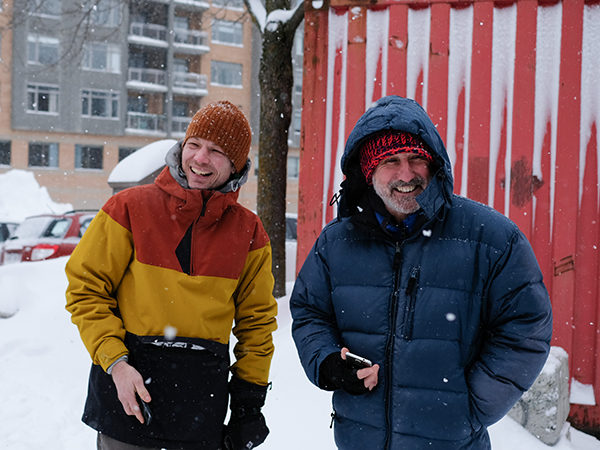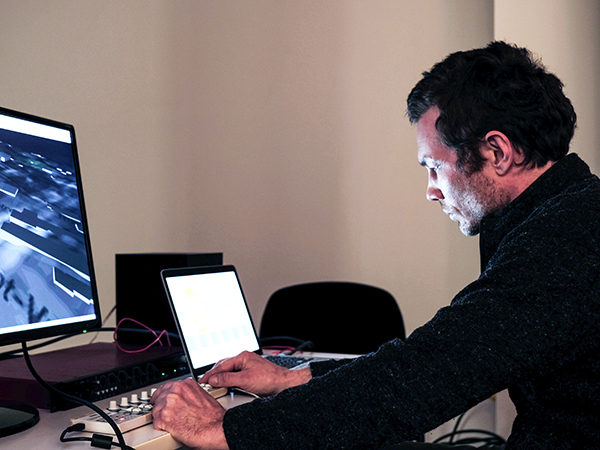City Sonorities
par Anne-Sophie Blanchet
Owen Chapman
from November 6 to December 17, 2017
Each era has its own ideas of utopia. They are indeed the obvious testaments to the challenges faced by the societies of yesterday and today. They are expressed, at times, in the architecture of a city, or in great political speeches, or through a conversation with friends… and often through the arts. If, since the time of Thomas More, it has been the issues of society that have occupied utopians, it is the environment that currently seems to be at the heart of twentieth-century preoccupations. For many contemporary artists, the city is thus seen as a laboratory for experimenting and exploring possibilities.

crédit photo: Carol-Ann Belzil-Normand
Last winter, in collaboration with Seconde Nature, LA CHAMBRE BLANCHE hosted artists Peter Sinclair and Owen Chapman as part of the Future DiverCities project. Over the next four years, Future DiverCities will bring together European and Quebecois creators and organizations to confront issues of urban mobility, cultural diversity, and civic engagement in the global society of today and tomorrow. For these collaborators, this project will promote artistic initiatives exploring new models of creation and diffusion with an inclusive perspective, fostering exchanges between art, science and communications.
Bringing together a French artist and a Quebecois artist whose paths had previously crossed multiple times, but never as part of a common creative project, this residency kick-started the conception of an artwork/device1, City Sonorities, whose finished form would change based on audience participation and the data generated by spectators. This project aimed to, among other things, explore various degrees of audience participation in order to create an immersive, evolving work of art. It also aimed to demonstrate other modes of representation, using sound as a real material that could reconfigure the sensory world and give shape to a long-desired utopia: a city without cars.

crédit photo: Carol-Ann Belzil-Normand
In concrete terms, City Sonorities presented an immersive experience happening in both the streets of Quebec City and in the virtual world of New Atlantis, a web platform created by Sinclair and Chapman. First, participants installed an application, especially designed for the project, onto their phones. Each participant was then assigned three tasks. The first was to exit LA CHAMBRE BLANCHE and walk for around fifteen minutes to get a bit of distance from the gallery.
Once participants decided that they were far enough away from the gallery, they then had to take a photo to create an avatar for the New Atlantis platform. They were also asked to record a sound they noticed around them, but not just any sound: a sound that was not interrupted by noise from cars. This was a considerable challenge, as the experience was based right in the heart of Quebec City’s lower town. However, participants were inventive and managed to capture the sound of a door slamming shut, the soft crunch of snow under their feet, a bird singing… then, through the application, participants would upload their avatars and the sounds they recorded to the artists.

crédit photo: Carol-Ann Belzil-Normand
The last task was to press the “Start Tracking” button, and participants gradually made their way back to the artist centre. Participants’ walking speed and paths taken were then transformed into digital data and transferred in real time to Sinclair and Chapman, who were already preparing the next part of the experience in the gallery. In the fifteen minutes the participants took to explore the city, the pair of artists transformed the data gathered into an original sonic work of art. Once back to the gallery, participants were invited to enter a setup of computer screens and speakers. They were, in fact, entering the virtual world of New Atlantis. Watching the monitors around them, they could see their avatars moving around in a mapped-out urban landscape and eventually converging in a meeting space that they guessed to be LA CHAMBRE BLANCHE. At the same time, they were immersed in a completely new sonic environment, created in real time by the artists using the sounds captured only minutes beforehand. Gradually, the audience discovered an urban world without cars, without roaring motors, without car horns… in essence, a city without the sonic omnipresence of cars, where other sounds could be experienced.

crédit photo: Carol-Ann Belzil-Normand
The project proved to be a meeting point between issues of mobility within urban centres and data processing with a goal of artistic creation. However, it was not so much a matter of verifying concepts or theories related to the utopia of a city without cars, but rather a reflection on other possible realities: opening a breach and launching a debate. Sinclair and Chapman perhaps wanted, rather, to offer multiple points of view, a plurality of trajectories and—at the end of the process—a common space to try something that could not have taken shape without the participation and collaboration of each individual. Together, the artists and the audience experienced the possibility of an urban space without automobiles, allowing them to explore new soundscapes. They also drew up a “digital city”, an embodiment of the relationship between cities and technology which, today, explores issues of civic engagement, business, service accessibility, urban sprawl…
With regard to sonic and digital art, this project also laid the groundwork for a reflection, both conceptual and aesthetic, on the relationship between sound and space, and sound and distance. By translating the sounds of the city into digital data, the artists created another language and, through this, another way of communicating, representing and testing urban environments. The artwork/device that was developed as part of this artistic residency thus called upon interactions, interferences and correlations between things near and far; between the interior of the gallery and the place in which it was located; between the virtual world and reality.
In sum, beyond demonstrating techniques and technologies for converting data, one of the goals of this experience was to express—using materials anchored in reality—another possibility, or rather, a multitude of possibilities. By doing this, City Sonorities enabled us to recognize our role and the space we occupy, not only as spectators and fans of contemporary art in the gallery, but also as city dwellers.
- Indeed, the residency gave rise to a second part in February 2018, but this time to the Centre National de Création Musicale de Marseille. See the following article for more details: City Without Cars, an utopian world between Quebec and Marseille . [Online], http://futuredivercities.eu/index.php/portfolio/city-without-cars-an-utopian-world-between-quebec-and-marseille/ (page viewed on January 11, 2019).